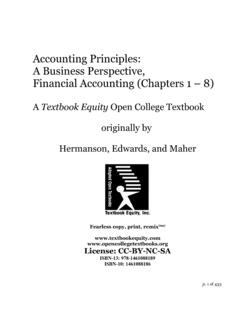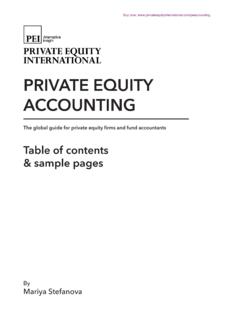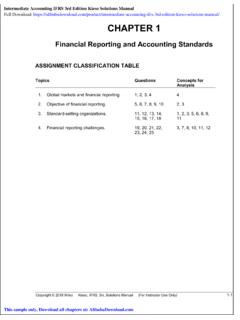Transcription of Time Value of Money and Its Applications In Corporate ...
1 American Journal of business Education September 2009 Volume 2, Number 6 77 Time Value Of Money And Its Applications In Corporate Finance: A Technical Note On Linking Relationships Between Formulas Jeng-Hong Chen, Albany State University, USA ABSTRACT Time Value of Money (TVM) is the most important chapter in the basic Corporate finance course. It is imperative to understand TVM formulas because they imply important TVM concepts. Students who really understand TVM concepts and formulas can learn better in chapters of TVM Applications . This technical note intends to present more complete TVM formulas and link their relationships from the growing annuity perspective to assist instructors in teaching and students in learning. Although TVM formulas are already available in the textbooks, this technical note provides another perspective of presenting and summarizing TVM formulas. The simplification or extension of the growing annuity formula to reach other TVM formulas is discussed in this note.
2 Keywords: Time Value of Money Formulas, The Growing Annuity 1. INTRODUCTION ime Value of Money (TVM) is the most important chapter in the basic Corporate finance course in business Students who really understand TVM concepts and formulas can learn better in TVM Applications , such as bond valuation, stock valuation, cost of capital, and capital budgeting. Due to the technological advancement, TVM formulas are built in the financial calculator and students can utilize its function keys to work TVM calculations efficiently. Although financial calculators help students compute answers faster, understanding TVM formulas is still imperative because these formulas imply important TVM concepts. With solid understanding of TVM formulas, students are able to identify what the questions ask and compute the correct answers by using either formulas or function keys.
3 When learning TVM, students may see many formulas listed in the textbook. Some students may think these formulas are difficult to understand because they are confused with these formulas. In fact, most of TVM formulas are closely related. When introducing TVM formulas, the instructor can classify them under different conditions and link their relationships to organize them. This way is easier for students to better understand these formulas and the essence of TVM. Moreover, students can learn better in TVM Applications , taught in later chapters. TVM formulas are available in the textbooks. Some textbooks only list frequently used formulas while others include more formulas. In addition, different textbooks present and organize TVM formulas in different ways. This technical note intends to present more complete TVM formulas and link their relationships from the growing annuity perspective to assist instructors in teaching and students in learning.
4 Although many TVM formulas listed in this technical note can be found in the textbooks, it provides another perspective of presenting and summarizing TVM formulas. The simplification or extension of the growing annuity formula to reach other TVM formulas is discussed in this note. The remainder of this technical note is organized as follows. Section 2 describes the growing annuity. Section 3 simplifies or extends the growing annuity formula to reach other TVM formulas and links their relationships. Section 4 concludes this note with tables summarizing TVM formulas discussed in section 3. T American Journal of business Education September 2009 Volume 2, Number 6 78 2. THE GROWING ANNUITY For the growing annuity, the payment is expected to grow at a constant rate for a finite number of periods. The formulas for the present Value (PV) of growing annuity and the future Value (FV) of growing annuity are shown as follows and derived in Appendix A.
5 GiigPMTPV nannuitygrowing 111 (1) gigiPMTFV nnannuitygrowing ))1()1(( (2) Where PMT: Payment at end of the first period (Payment one period from today) g: the payment growth rate per period i: the interest rate per period2 n: number of periods 3. OTHER TVM FORMULAS Other TVM formulas can be achieved by simplifying or extending equation (1) or (2), the formula for the PV or FV of growing annuity. Present Value Interest Factor Annuity (PVIFAi,n) Present Value interest factor annuity (PVIFAi,n) represents the PV of $1 payment (PMT = $1) occurred at end of each period for a finite number of periods. PVIFAi,n, which requires PMT = $1 and g = 0 (zero growth rate because of the same amount of PMT each period), is a special case of PV of growing annuity. When PMT = $1 and g = 0, equation (1) will be simplified to the following equation (3). iiPVIFAnni )1(11, (3) Many finance and accounting textbooks put PVIFAi,n table in the appendix.
6 The numbers in table are made based on equation (3). Present Value (PV) of Ordinary Annuity PV of ordinary annuity means the PV of same PMT (PMT > $0) occurred at end of each period for a finite number of periods. PV of ordinary annuity, which requires g = 0 (zero growth rate because of the same amount of PMT each period), is a special case of PV of growing annuity. To get PV of ordinary annuity, we can either simplify equation (1) by assuming g = 0 or use PMT to multiply by equation (3). So, let g = 0 in equation (1) or use PMT to multiply by equation (3). PV of ordinary annuity can be reached as follow. American Journal of business Education September 2009 Volume 2, Number 6 79 ninannuityordinaryPVIFAPMTiiPMTPV,)1(11 (4) Present Value (PV) of Annuity Due Comparing annuity due with ordinary annuity, we can find the following relationship. )1(iPVPV annuityordinarydueannuity (5) The detailed proof of equation (5) is shown in Appendix B.
7 Use equation (3) to multiply by (1+i). We get 11)1(11)1(1)1()1()1(11)1(1,11, ninnnniPVIFA iiiiiiiiiPVIFA (6) Combine equation (4), (5), and (6). PV of annuity due can be written as follow. )1()1(1,, ninidueannuityPVIFAPMTiPVIFAPMTPV (7) Future Value Interest Factor Annuity (FVIFAi,n) Future Value interest factor annuity (FVIFAi,n) represents the future Value (FV) of $1 payment (PMT = $1) occurred at end of each period for a finite number of periods. FVIFAi,n, which requires PMT = $1 and g = 0 (zero growth rate because of the same amount of PMT each period), is a special case of FV of growing annuity. When PMT = $1 and g = 0, equation (2) will be simplified to the following equation (8).3 iiFVIFAnni)1)1((, (8) Many finance and accounting textbooks also put FVIFAi,n table in the appendix. The numbers in table are made based on equation (8). Future Value (FV) of Ordinary Annuity FV of ordinary annuity means the FV of same PMT (PMT > $0) occurred at end of each period for a finite number of periods.
8 FV of ordinary annuity, which requires g = 0 (zero growth rate because of the same amount of PMT each period), is a special case of FV of growing annuity. To get FV of ordinary annuity, we can either simplify equation (2) by assuming g = 0 or use PMT to multiply by equation (8). So, let g = 0 in equation (2) or use PMT to multiply by equation (8). FV of ordinary annuity can be reached as follow. American Journal of business Education September 2009 Volume 2, Number 6 80 ninannuityordinaryFVIFAPMTiiPMTFV,)1)1(( (9) Future Value (FV) of Annuity Due Comparing annuity due with ordinary annuity, we can find the following relationship. )1(iFVFV annuityordinarydueannuity (10) The detailed proof of equation (10) is also shown in Appendix B. Use equation (8) to multiply by (1+i). We get 11)1)1(())1()1(()1()1)1(()1(1,11, ninnnniFVIFA iiiiiiiiiFVIFA (11) Combine equation (9), (10), and (11).
9 FV of annuity due can be written as follow. )1()1(1,, ninidueannuityFVIFAPMTiFVIFAPMTFV (12) Perpetuity and Stock Valuation (Zero Growth Common Stock and Preferred Stock) Perpetuity Perpetuity defines that the same amount of PMT per period occurs forever. Therefore, PMT is the same for each period (g = 0, zero growth rate) and the number of periods is infinite (n ). Again, based on equation (1), when g = 0 and n , nniig 1111 0. 4 So, the present Value of perpetuity will become iPMTPV perpetuity (13) Stock Valuation: Common Stock (Zero Growth Model) Zero growth common stock assumes that the expected future dividend per period will be the same and it will last forever. Actually, this is the same situation as what we discussed for perpetuity. The formula to calculate the Value of stock today (P0) should be the same as equation (13) except using different notations.
10 SkDP 0 (14) In equation (14), D, the expected future dividend per share per period, is like PMT in equation (13) and ks, the required rate of return on common stock per period, is like i in equation (13). American Journal of business Education September 2009 Volume 2, Number 6 81 Stock Valuation: Preferred Stock Preferred stock has the same situation as perpetuity and zero growth common stock. The fixed amount of dividend is expected to last forever. Again, the formula to calculate the Value of preferred stock today (Vp) should be the same as equation (13) and (14) except using different notations. pppkDV (15) In equation (15), Dp, the fixed amount of preferred stock dividend per share per period, is like PMT in equation (13) and D in equation (14). kp, the required rate of return on preferred stock per period, is like i in equation (13) and ks in equation (14).5 Stock Valuation: Common Stock (Constant Growth Model) The constant growth model assumes that the stock dividend per period is expected to grow at the constant rate (g) forever (n ) and the required rate of return should be greater than the dividend growth rate (ks > g).

















